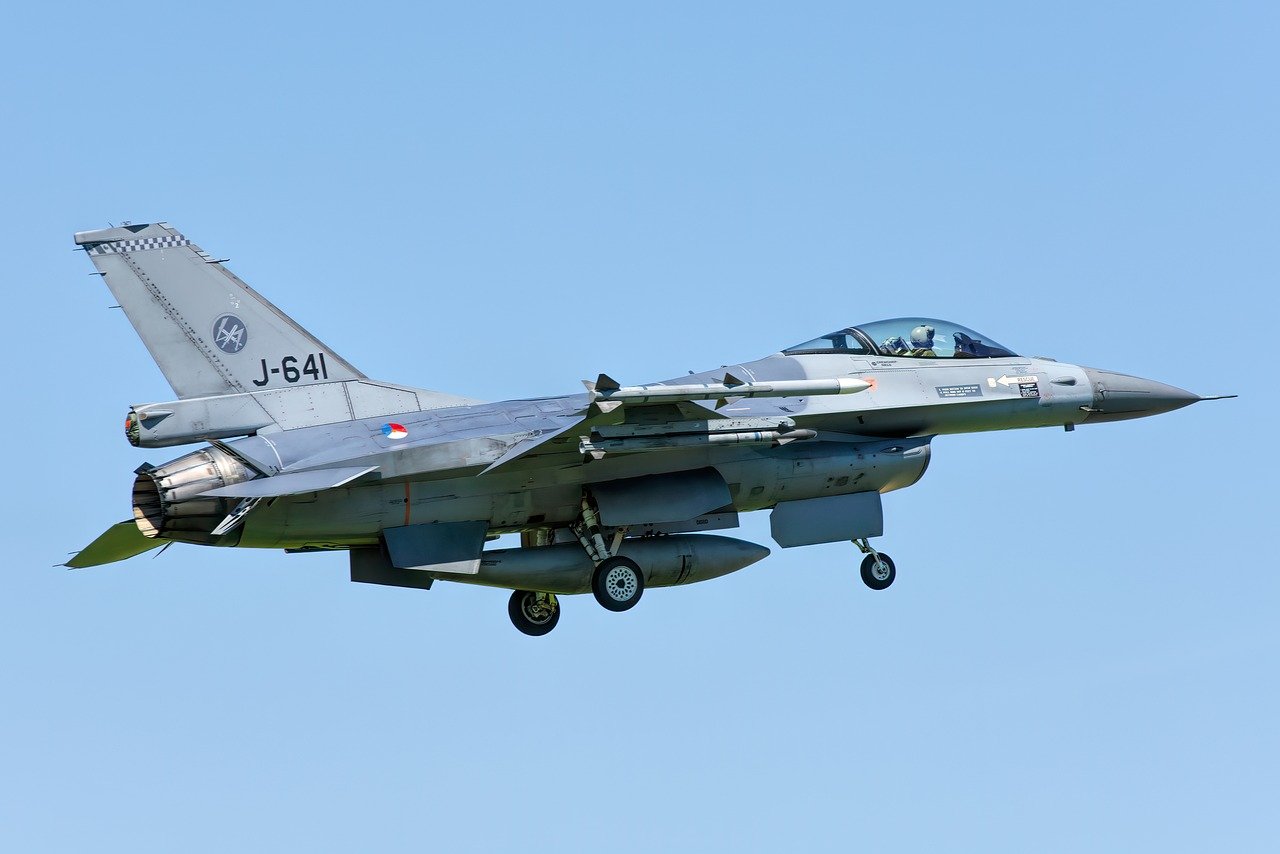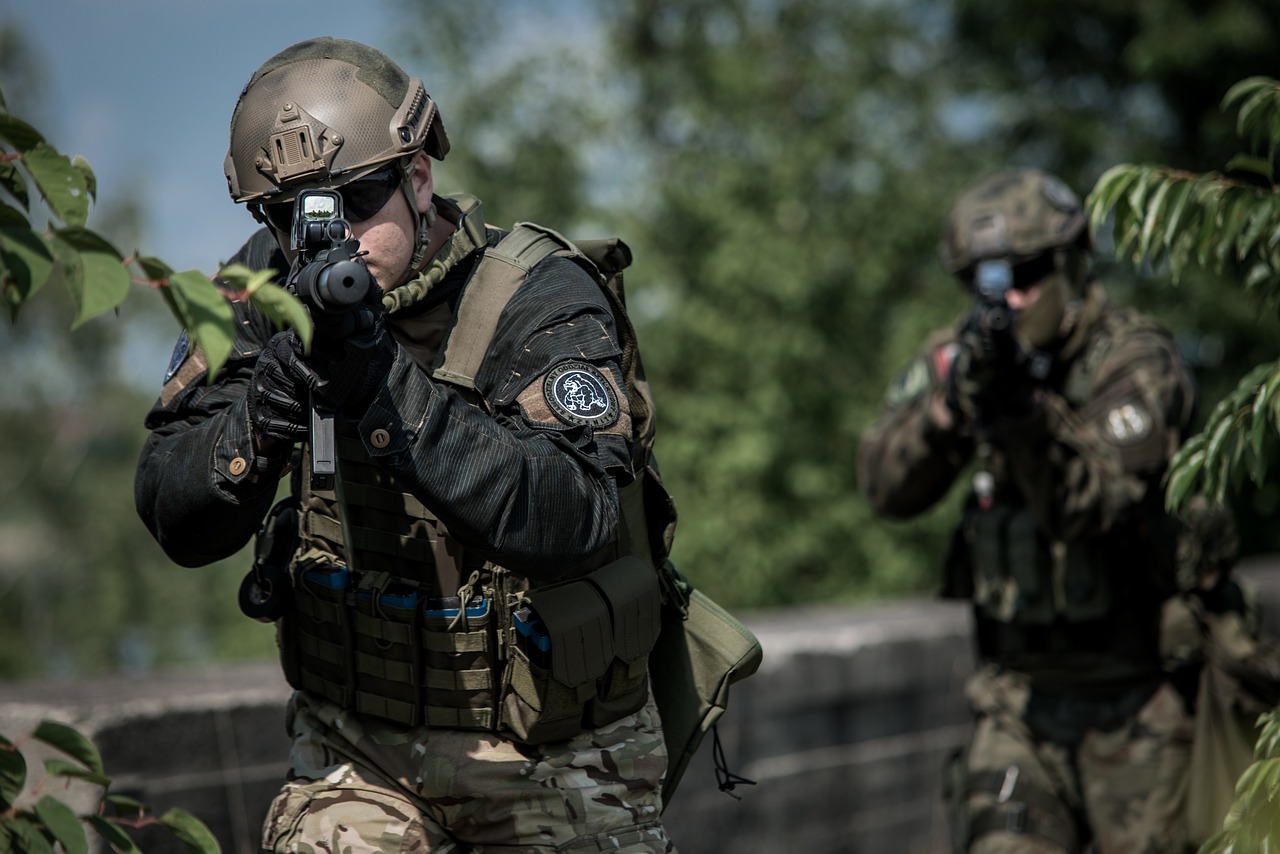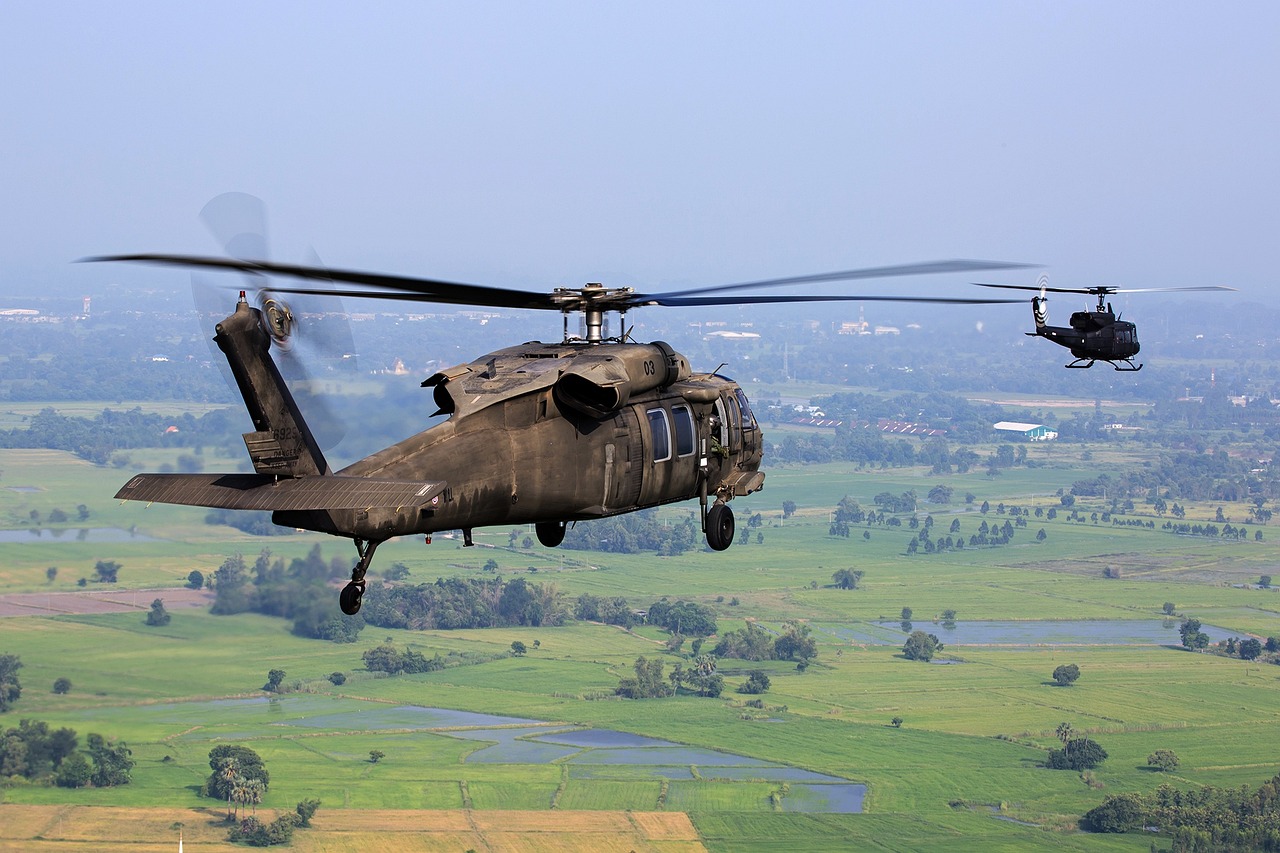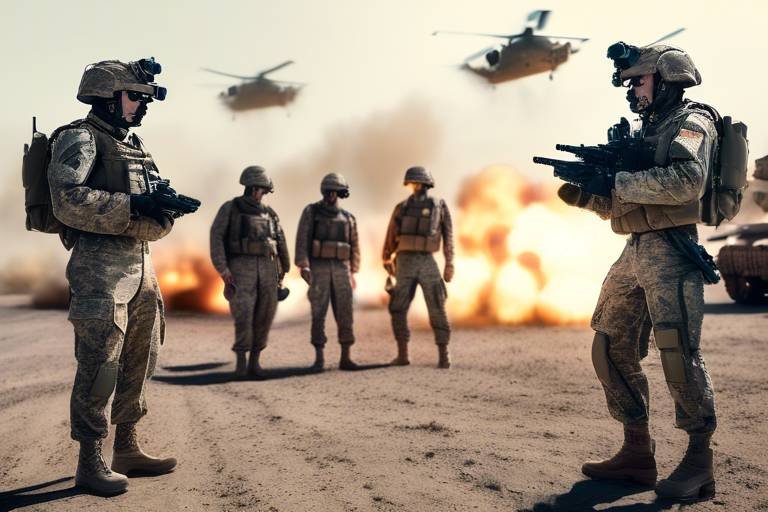The Role of AI in Enhancing Battlefield Command Decisions
In the fast-paced world of modern warfare, the stakes are higher than ever. Commanders are no longer just strategists; they are now decision-makers who must navigate a complex landscape filled with rapid changes and unpredictable threats. This is where artificial intelligence (AI) steps in, revolutionizing the way military operations are conducted. Imagine having a partner that can process vast amounts of data in the blink of an eye, offering insights that could mean the difference between victory and defeat. Isn't that a game-changer?
AI is not just a buzzword; it’s a powerful tool that is reshaping the battlefield. From real-time data analysis to predictive modeling, AI technologies are enhancing decision-making processes. Commanders can now access actionable insights that improve their situational awareness, allowing them to make informed decisions quickly. Think of AI as a highly skilled assistant, tirelessly working behind the scenes to ensure that every strategic move is backed by solid data and analysis.
As we delve deeper into the role of AI in military strategies, it’s essential to understand its fundamental applications. AI technologies are not merely supplementary; they are integral to modern warfare. They are transforming traditional paradigms, making warfare more efficient and effective. In this new era, commanders are equipped with tools that not only enhance their capabilities but also redefine how they approach challenges on the battlefield.
Moreover, the integration of AI into military operations is not without its challenges. While the benefits are immense, the transition requires careful consideration of existing systems and protocols. Commanders must navigate the complexities of merging AI technologies with traditional military frameworks. This seamless integration is crucial for maximizing operational efficiency and ensuring that AI enhances, rather than complicates, command decisions.
- How does AI improve decision-making in military operations?
AI improves decision-making by providing real-time data analysis and predictive insights, allowing commanders to make informed choices quickly. - What are the ethical concerns surrounding AI in warfare?
Ethical concerns include accountability for AI-driven decisions, the potential for bias in algorithms, and the implications of autonomous systems in combat. - Will AI replace human commanders on the battlefield?
No, AI is designed to assist human commanders, enhancing their capabilities rather than replacing them. - What future trends can we expect in AI and military strategy?
Future trends include advancements in autonomous systems, collaborative AI, and enhanced command capabilities, all aimed at improving battlefield effectiveness.

Understanding AI in Military Context
Artificial Intelligence (AI) is not just a buzzword; it's a revolutionary force that's reshaping the landscape of military operations. Imagine a battlefield where decisions are made not just by human intuition but also by sophisticated algorithms that can analyze vast amounts of data in real-time. This is the essence of AI in the military context. It combines advanced computational techniques with the strategic acumen of military leaders, creating a synergy that enhances operational effectiveness.
At its core, AI encompasses a range of technologies, including machine learning, natural language processing, and robotics. These technologies work together to provide military commanders with tools that can predict outcomes, assess risks, and suggest optimal courses of action. For instance, machine learning algorithms can sift through historical data to identify patterns that might be invisible to the human eye, offering insights that can inform tactical decisions. This not only saves time but also increases the accuracy of predictions, which is crucial in high-stakes environments.
Furthermore, AI is transforming traditional warfare paradigms in several key ways:
- Enhanced Situational Awareness: AI systems can process data from various sources, including satellites, drones, and ground sensors, to provide a comprehensive view of the battlefield.
- Improved Decision-Making: By analyzing real-time data, AI can assist commanders in making informed decisions quickly, which is vital in dynamic combat situations.
- Resource Optimization: AI can help allocate resources more efficiently, ensuring that troops have what they need when they need it.
As we delve deeper into the applications of AI in military contexts, it's essential to recognize the challenges that accompany these advancements. Integrating AI into existing military frameworks requires not only technological upgrades but also a cultural shift within military organizations. Commanders and soldiers alike must be trained to trust and work alongside AI systems, which can be a daunting task given the traditional nature of military operations.
In summary, understanding AI in the military context is about more than just technology; it's about rethinking how we approach warfare and decision-making. As AI continues to evolve, it promises to unlock new capabilities that can significantly alter the way military operations are conducted, making them faster, more efficient, and ultimately more effective.
- What is AI in military operations? AI in military operations refers to the use of advanced algorithms and technologies to enhance decision-making, situational awareness, and operational efficiency on the battlefield.
- How does AI improve decision-making in the military? AI improves decision-making by analyzing vast amounts of data quickly, providing commanders with actionable insights and predictions based on real-time information.
- What are some challenges of using AI in the military? Challenges include integrating AI with existing systems, ensuring data accuracy, and addressing ethical concerns related to accountability and bias.

AI-Powered Decision Support Systems
In the fast-paced world of modern warfare, the need for rapid and informed decision-making is more critical than ever. Enter , which are revolutionizing how military commanders approach strategic planning and operational execution. These systems harness the immense power of artificial intelligence to sift through mountains of data, providing actionable insights that enhance situational awareness on the battlefield. Imagine having a personal assistant who can analyze complex scenarios faster than a human ever could; that’s precisely what AI brings to the table.
At the heart of these systems lies a robust framework that integrates real-time data analysis, predictive modeling, and advanced algorithms. The result? Commanders are equipped with the information they need to make decisions that can mean the difference between victory and defeat. With AI, the fog of war is lifted, allowing for a clearer understanding of the battlefield landscape. This is not just about crunching numbers; it's about transforming raw data into strategic advantages.
Data collection is the backbone of any effective military operation. AI algorithms excel in gathering and analyzing vast amounts of information from various sources, including satellite imagery, reconnaissance reports, and social media feeds. This comprehensive data collection ensures that commanders have a holistic view of the battlefield. For instance, AI can process signals intelligence to identify enemy communications or analyze terrain data to inform tactical movements.
One of the standout features of AI-powered decision support systems is their ability to provide real-time intelligence. Imagine a scenario where a commander receives up-to-the-minute updates on enemy troop movements or changes in weather conditions. With AI, this is not a distant dream but a current reality. The system continuously monitors the battlefield, processing incoming data and flagging critical updates that require immediate attention. This capability enables commanders to adapt their strategies swiftly, ensuring they stay one step ahead of the enemy.
Predictive analytics is another game-changer in the realm of military strategy. By leveraging historical data and current trends, AI can forecast potential enemy movements and outcomes. This foresight allows commanders to make proactive decisions rather than merely reacting to events as they unfold. For example, if AI predicts a potential enemy attack based on troop movements, commanders can reposition their forces or reinforce vulnerable areas before an assault occurs. This proactive approach is akin to having a crystal ball that offers insights into future battlefield dynamics.
While the benefits of AI-powered decision support systems are clear, integrating these technologies with existing military systems can present challenges. It requires careful planning and execution to ensure a seamless transition. However, the potential for enhanced operational efficiency is worth the effort. By marrying traditional military systems with cutting-edge AI technology, armed forces can create a more cohesive and effective command structure.
In summary, AI-powered decision support systems are transforming military strategies by enhancing decision-making processes and situational awareness. As these technologies continue to evolve, they promise to reshape how commanders approach warfare, making them more agile, informed, and effective in the face of ever-changing battlefield conditions.
- What are AI-powered decision support systems? These systems use artificial intelligence to analyze data and provide insights that assist military commanders in making informed decisions.
- How does AI improve situational awareness? AI processes vast amounts of real-time data, enabling commanders to have a clearer understanding of the battlefield and make timely decisions.
- What role does predictive analytics play in military operations? Predictive analytics helps forecast enemy movements and potential outcomes, allowing for proactive strategic adjustments.
- What challenges exist in integrating AI with military systems? Integration challenges include ensuring compatibility with existing systems and training personnel to effectively use AI technologies.

Data Collection and Analysis
In the rapidly evolving landscape of military operations, play a pivotal role in shaping effective command decisions. Imagine a battlefield where every movement, every sound, and every piece of intelligence is meticulously gathered and processed. This is not just a dream; it's the reality facilitated by advanced artificial intelligence (AI) technologies. By harnessing the power of AI, military forces can transform vast amounts of raw data into actionable insights that enhance situational awareness and decision-making capabilities.
At the heart of this transformation lies the ability to collect data from a myriad of sources, including satellite imagery, drone surveillance, and ground sensors. Each of these sources contributes unique information that, when combined, paints a comprehensive picture of the battlefield. For instance, satellite imagery can reveal troop movements across vast areas, while drone surveillance can provide real-time updates on enemy positions. Ground sensors can detect changes in the environment, such as unexplained noises or movements, alerting commanders to potential threats. The integration of these data sources is crucial for developing a holistic understanding of the operational landscape.
Once data is collected, the next step is analysis. AI algorithms are designed to sift through this overwhelming volume of information, identifying patterns and trends that human analysts might overlook. This process not only speeds up decision-making but also enhances accuracy. Consider a scenario where a commander must decide whether to engage an enemy unit. With AI-powered analysis, the commander can access predictive models that forecast enemy movements based on historical data and current battlefield conditions. This capability allows military leaders to make informed choices, reducing the risk of costly mistakes.
Furthermore, the role of AI in real-time intelligence gathering cannot be overstated. As situations evolve on the battlefield, having up-to-the-minute data is essential. AI systems can continuously analyze incoming data streams, providing commanders with the latest intelligence. This immediacy is crucial in situations where decisions must be made within seconds. For example, if a drone detects an unexpected enemy formation, AI can quickly assess the implications and recommend strategic adjustments, ensuring that commanders have the upper hand.
Moreover, the use of predictive analytics in warfare is revolutionizing how military operations are conducted. By analyzing historical data and current trends, AI can forecast potential enemy actions, allowing commanders to anticipate and counter threats effectively. For instance, if data indicates that an enemy unit typically launches assaults at dawn, AI can suggest preemptive measures, such as repositioning troops or enhancing defenses during those critical hours. This proactive approach not only enhances operational readiness but also instills a sense of confidence among military leaders.
In summary, the integration of AI in data collection and analysis is fundamentally reshaping military command decisions. With the ability to gather vast amounts of data from diverse sources and analyze it in real-time, military leaders are better equipped to navigate the complexities of modern warfare. The result is a more agile, informed, and effective command structure capable of responding to the dynamic challenges of the battlefield.
- How does AI improve data collection in military operations?
AI enhances data collection by integrating information from multiple sources, such as satellites, drones, and sensors, providing a comprehensive view of the battlefield. - What role does predictive analytics play in military decision-making?
Predictive analytics helps forecast enemy movements and potential threats, allowing commanders to make proactive strategic adjustments. - Can AI replace human decision-makers in the military?
No, AI is designed to assist and enhance human decision-making, ensuring that commanders maintain oversight and control.

Real-Time Intelligence Gathering
In the fast-paced world of modern warfare, the ability to gather intelligence in real-time is nothing short of revolutionary. Imagine a battlefield where every second counts and decisions need to be made swiftly; this is where artificial intelligence steps in as a game-changer. AI-powered systems can process vast amounts of data from various sources, such as surveillance drones, satellite imagery, and ground sensors, allowing military commanders to gain a comprehensive understanding of the battlefield situation almost instantaneously.
Real-time intelligence gathering enables military leaders to respond to threats and opportunities as they arise. For instance, when enemy movements are detected, AI algorithms can analyze patterns and predict future actions, giving commanders the foresight needed to make informed decisions. This capability is akin to having a crystal ball that not only shows the present but also hints at what might come next. With AI, the fog of war begins to lift, revealing critical insights that were previously buried under mountains of data.
One of the standout features of AI in intelligence gathering is its ability to integrate multiple data streams. This means that information from different sources can be combined to create a more nuanced picture of the battlefield. For example, by correlating data from reconnaissance missions with social media feeds, AI can identify potential insurgent activities or civilian movements that could impact military operations. This integration not only enhances situational awareness but also minimizes the risk of misinformation, which can lead to catastrophic mistakes.
To illustrate the importance of real-time intelligence gathering, consider the following table that highlights the key benefits of AI in this domain:
| Benefit | Description |
|---|---|
| Speed | AI can analyze data in seconds, providing commanders with immediate insights. |
| Accuracy | Advanced algorithms reduce human error, ensuring more reliable intelligence. |
| Comprehensive Analysis | AI integrates diverse data sources for a holistic view of the battlefield. |
| Predictive Capabilities | AI can forecast enemy actions based on historical data and current trends. |
Moreover, the use of machine learning techniques allows AI systems to improve over time. As they process more data, they become better at identifying patterns and anomalies, further enhancing their predictive capabilities. This continuous learning aspect means that the intelligence gathered today can inform and refine future operations, creating a cycle of improvement that is crucial in the ever-evolving landscape of warfare.
In conclusion, real-time intelligence gathering powered by AI is not just a technological advancement; it's a critical component that enhances battlefield effectiveness. By providing commanders with timely and accurate information, AI transforms the decision-making process, allowing military forces to act decisively and strategically in the face of uncertainty.
- How does AI improve real-time intelligence gathering?
AI enhances real-time intelligence by processing vast amounts of data quickly and accurately, allowing for better situational awareness and decision-making. - What types of data can AI analyze for military intelligence?
AI can analyze data from surveillance drones, satellite imagery, ground sensors, and even social media feeds to provide a comprehensive view of the battlefield. - Can AI predict enemy movements?
Yes, AI uses predictive analytics to forecast potential enemy actions based on historical data and current battlefield conditions. - What are the ethical concerns surrounding AI in military operations?
Ethical concerns include accountability for AI-driven decisions, potential biases in algorithms, and the implications of autonomous systems in warfare.

Predictive Analytics in Warfare
In the ever-evolving landscape of modern warfare, predictive analytics has emerged as a game-changer, revolutionizing how military strategists approach planning and decision-making. Imagine a chess game where you not only anticipate your opponent's next move but can also foresee their entire strategy based on previous patterns. That's precisely what predictive analytics enables military leaders to do. By harnessing vast amounts of data—from troop movements to environmental conditions—AI algorithms can forecast potential enemy actions and outcomes with remarkable accuracy.
At its core, predictive analytics utilizes historical data to identify trends and patterns that might not be immediately apparent to human analysts. For instance, if a particular enemy unit typically attacks at dawn after a period of reconnaissance, AI can highlight this behavior, allowing commanders to prepare defenses or launch preemptive strikes. This proactive approach is akin to having a weather forecast for battle; it provides the foresight needed to make informed decisions that could mean the difference between victory and defeat.
Moreover, the integration of predictive analytics into military operations enhances situational awareness significantly. Commanders can visualize a range of possible scenarios based on current data, enabling them to craft strategies that are not only reactive but also anticipatory. For example, consider a scenario where intelligence reports suggest an enemy buildup near a border. Predictive analytics can analyze past engagements, troop movements, and even social media sentiments to project the likelihood of an impending attack, thereby allowing for timely reinforcements or strategic repositioning.
However, the application of predictive analytics is not without its challenges. The complexity of warfare means that many variables are at play, and while AI can analyze data at lightning speed, it is still reliant on the quality and accuracy of the input data. Poor data can lead to miscalculations, which might have grave consequences in real-world scenarios. Therefore, ensuring robust data collection and validation processes is crucial to the efficacy of predictive analytics in military contexts.
To better illustrate the impact of predictive analytics, consider the following table that outlines key benefits and potential challenges:
| Benefits | Potential Challenges |
|---|---|
| Enhanced situational awareness | Data quality and accuracy issues |
| Proactive decision-making | Complexity of interpreting data |
| Improved resource allocation | Integration with existing systems |
| Increased operational efficiency | Ethical implications of predictive decisions |
In conclusion, predictive analytics holds immense potential to reshape military strategies, offering commanders a powerful tool to foresee and respond to threats effectively. As technology continues to advance, the integration of AI-driven predictive analytics will likely become a standard practice in military operations, ensuring that decisions are not just based on instinct but are backed by data-driven insights. This shift not only enhances battlefield effectiveness but also elevates the art of war to a new level of precision and foresight.
- What is predictive analytics in warfare? Predictive analytics in warfare involves using historical data and AI algorithms to forecast potential enemy actions and battlefield outcomes, enabling military strategists to make informed decisions.
- How does predictive analytics improve military decision-making? It enhances decision-making by providing commanders with insights into possible future scenarios based on current and past data, allowing for proactive strategies.
- What challenges does predictive analytics face in military applications? Challenges include data quality issues, the complexity of interpreting vast amounts of information, and ethical concerns regarding the implications of AI-driven decisions.

Integration of AI with Existing Systems
Integrating artificial intelligence with existing military systems is not just a technical challenge; it’s a transformative journey that can redefine how operations are conducted on the battlefield. As military forces around the globe increasingly rely on advanced technologies, the seamless integration of AI becomes paramount for enhancing operational efficiency and effectiveness. However, this journey is fraught with both challenges and opportunities.
One of the primary challenges lies in the compatibility of AI technologies with legacy systems. Many military operations still depend on older technology that may not easily interface with modern AI solutions. This can lead to significant hurdles in data sharing and communication. To overcome these hurdles, military organizations must invest in upgrading their infrastructure and ensuring that new AI systems can communicate effectively with existing tools. This often involves extensive testing and validation to ensure that integration does not compromise operational integrity.
Moreover, the training and adaptation of personnel to work alongside AI systems is crucial. Commanders and soldiers must understand how to leverage AI insights to make informed decisions. This requires comprehensive training programs that not only teach the technical aspects of the AI systems but also emphasize the importance of human judgment in interpreting AI-generated data. The relationship between human operators and AI should be viewed as a collaborative partnership, where both parties enhance each other’s capabilities.
Additionally, there are significant benefits to integrating AI with existing military systems. For instance, AI can enhance data processing speeds, allowing for quicker response times in critical situations. With AI-driven systems, commanders can access real-time information, enabling them to make more informed decisions swiftly. This is particularly vital in combat scenarios where every second counts. Furthermore, AI can help to synthesize vast amounts of data from various sources, providing a comprehensive overview of the battlefield that human analysts might struggle to achieve alone.
To illustrate the potential benefits and challenges of AI integration, consider the following table that summarizes key aspects:
| Aspect | Benefits | Challenges |
|---|---|---|
| Data Processing | Faster analysis and decision-making | Integration with legacy systems |
| Real-Time Insights | Enhanced situational awareness | Training personnel |
| Operational Efficiency | Streamlined processes | Resource allocation for upgrades |
Ultimately, the integration of AI into military systems is a balancing act between leveraging cutting-edge technology and maintaining the human element that is so vital in warfare. As the military navigates this landscape, it must remain vigilant about the implications of AI, ensuring that advancements are implemented responsibly and ethically. The road ahead is filled with promise, but it also requires careful consideration of how best to integrate these powerful tools into the fabric of military operations.
- What are the main challenges in integrating AI with existing military systems?
The main challenges include compatibility issues with legacy systems, the need for extensive training of personnel, and the allocation of resources for necessary upgrades. - How can AI enhance decision-making in military operations?
AI can provide real-time data analysis and predictive insights, allowing commanders to make informed decisions quickly in dynamic environments. - What role does human judgment play in AI-driven military decisions?
Human judgment remains crucial as AI systems provide data, but commanders must interpret and apply this information within the context of the situation.

Ethical Considerations of AI in Warfare
The integration of artificial intelligence (AI) into military operations has sparked intense debate surrounding its ethical implications. As we stand on the brink of a new era in warfare, questions about accountability, decision-making autonomy, and the potential for unintended consequences loom large. The reality is that while AI can enhance battlefield effectiveness, it also raises profound moral dilemmas that cannot be ignored.
One of the most pressing concerns is accountability in AI-driven decisions. When an AI system makes a decision that leads to a significant outcome, who is responsible? Is it the programmer who designed the algorithm, the military personnel who deployed it, or the AI itself? This ambiguity can create a moral gray area, making it difficult to hold anyone accountable for actions taken on the battlefield. The implications are staggering: if an AI system miscalculates and results in civilian casualties, the question of who bears responsibility becomes crucial. This dilemma is not just theoretical; it has real-world implications that could affect military operations and international relations.
Moreover, the potential for bias and fairness in AI algorithms presents another ethical challenge. AI systems are only as good as the data they are trained on. If the training data contains biases—whether racial, cultural, or socioeconomic—these biases can be perpetuated in decision-making processes. For instance, if an AI system is trained predominantly on data from one demographic, it may misinterpret or overlook critical information about others. This could lead to unfair treatment of individuals or groups during military operations, raising ethical concerns about justice and equality in warfare.
Furthermore, the autonomy of AI systems in combat scenarios raises questions about the role of human oversight. As AI technology becomes more advanced, there is a temptation to allow machines to make decisions without human intervention. However, this shift could lead to scenarios where machines make life-and-death decisions, potentially without the moral reasoning that human commanders possess. The risk of machines operating without ethical frameworks could lead to catastrophic outcomes, underscoring the need for clear guidelines on the use of AI in military contexts.
In light of these ethical considerations, it is crucial for military leaders, policymakers, and technologists to engage in ongoing discussions about the responsible use of AI in warfare. Establishing ethical frameworks and guidelines can help mitigate risks associated with AI deployment. This could involve:
- Developing robust accountability mechanisms for AI-driven decisions.
- Ensuring diverse training data to reduce biases in AI algorithms.
- Maintaining human oversight in critical decision-making processes.
Ultimately, as we navigate the complexities of AI in warfare, it is imperative to balance technological advancements with ethical responsibilities. The future of military operations will depend not only on how effectively we harness AI but also on how responsibly we manage its implications.
Q1: What are the main ethical concerns regarding AI in warfare?
A1: The primary ethical concerns include accountability for AI-driven decisions, potential biases in AI algorithms, and the autonomy of AI systems in making life-and-death decisions without human oversight.
Q2: How can military organizations ensure accountability for AI decisions?
A2: Establishing clear guidelines and accountability mechanisms, such as identifying responsible parties and maintaining logs of AI decision-making processes, can help ensure accountability.
Q3: What steps can be taken to reduce biases in AI algorithms?
A3: Ensuring diverse and representative training data, ongoing monitoring for bias, and involving multidisciplinary teams in AI development can help reduce biases.
Q4: Is it possible for AI to operate ethically in military contexts?
A4: While AI can enhance decision-making, ethical frameworks and human oversight are essential to ensure that AI systems operate within acceptable moral boundaries.

Accountability in AI-Driven Decisions
As we delve into the realm of artificial intelligence (AI) in military operations, one of the most pressing concerns that arise is the issue of accountability. When AI systems are tasked with making critical decisions on the battlefield, it raises a fundamental question: who is responsible for those decisions? This dilemma is not merely theoretical; it has real-world implications that can affect lives, strategies, and the very nature of warfare itself.
Imagine a scenario where an AI system misinterprets data and mistakenly identifies a civilian target as a threat, leading to catastrophic consequences. In such a case, would the blame lie with the programmers who designed the algorithm, the military personnel who deployed it, or the AI itself? This ambiguity complicates the ethical landscape of military AI deployment. The chain of command becomes murky when decisions are made by systems that operate beyond human oversight.
To better understand this accountability issue, we can categorize the stakeholders involved in AI-driven decisions:
- Developers: Those who create the algorithms and systems.
- Military Commanders: Personnel who utilize AI systems for strategic decisions.
- Governments: Entities that establish the legal frameworks governing AI use in warfare.
- Society: The public that is affected by the outcomes of these decisions.
Each of these groups plays a role in the decision-making process, yet pinpointing accountability can be challenging. The complexity increases when we consider that AI systems often learn and adapt over time, potentially leading to unanticipated behaviors that their creators did not foresee. This unpredictability raises questions about moral responsibility and whether AI can be held accountable in the same way humans are.
Moreover, the legal implications of AI-driven decisions are still being explored. As military operations evolve and AI becomes more integrated into strategic planning, there is an urgent need for clear regulations that delineate responsibility. Without such guidelines, we risk creating a scenario where no one is held accountable for the actions of AI, leading to a potential lack of oversight and control.
In conclusion, the question of accountability in AI-driven military decisions is not just a technical issue; it is a profound ethical challenge that demands attention. As we move forward into an era where AI will play an increasingly significant role in warfare, it is essential to establish frameworks that ensure accountability, transparency, and ethical responsibility. Only then can we harness the power of AI while safeguarding humanity's moral compass in the chaotic theater of war.
- What is AI accountability in military operations?
AI accountability refers to the responsibility for decisions made by artificial intelligence systems in military contexts, addressing who is liable when AI systems cause harm or make errors. - Who is responsible for AI decisions in the military?
Responsibility can fall on multiple stakeholders, including developers, military commanders, and governing bodies, but clear lines of accountability are still being defined. - What are the ethical implications of AI in warfare?
Ethical implications include concerns about decision-making autonomy, the potential for bias in AI algorithms, and the moral responsibility of those who deploy AI systems.

Bias and Fairness in AI Algorithms
As we dive deeper into the world of artificial intelligence, one of the most pressing issues that arises is bias in AI algorithms. The military, like any other sector, relies heavily on data-driven decision-making, but what happens when the data itself is flawed? Bias can creep in from various sources, including historical data that reflects past prejudices, leading to decisions that may not be fair or just. This is particularly concerning in military contexts where the stakes are incredibly high, and the implications of biased decisions can be dire.
Imagine a battlefield scenario where AI systems are tasked with identifying threats based on historical data. If that data is biased—say, it disproportionately flags certain groups based on previous conflicts—the AI may misidentify threats, potentially leading to catastrophic outcomes. This is why understanding the origins of bias in AI algorithms is crucial. It’s not just about coding; it’s about the data we feed into these systems. Data can be unintentional carriers of bias, and if we’re not careful, we could end up perpetuating cycles of unfairness.
Moreover, the concept of fairness in AI is not just a technical challenge; it’s a moral imperative. Military leaders must ensure that the algorithms they use do not reinforce existing inequalities or introduce new forms of bias. This requires a concerted effort to scrutinize data sources, refine algorithms, and implement rigorous testing protocols. Transparency is key here. By being open about how data is collected and used, military organizations can foster trust and accountability in AI-driven decisions.
To better understand the implications of bias in AI algorithms, consider the following factors that contribute to bias:
- Data Selection: The choice of data can significantly impact the outcomes of AI algorithms. If the data is not representative of the population, it can lead to skewed results.
- Algorithm Design: The way algorithms are structured can introduce bias. For instance, if the algorithm prioritizes certain features over others, it may overlook critical aspects.
- Human Oversight: Human biases can inadvertently influence how AI systems are trained and deployed. It’s essential to have diverse teams in AI development to mitigate this risk.
In response to these challenges, many military organizations are now prioritizing fairness and bias mitigation strategies in their AI implementations. This includes adopting best practices such as:
- Conducting regular audits of AI systems to identify and rectify biases.
- Implementing diverse data sets that reflect a wide range of scenarios and demographics.
- Engaging with ethicists and social scientists to better understand the societal impacts of AI decisions.
Ultimately, the goal is to create AI systems that not only enhance battlefield decision-making but do so in a way that is fair and just. As we move forward, the military must remain vigilant about the potential biases in AI algorithms and strive to ensure that these technologies serve to protect all individuals, rather than perpetuate inequalities.
- What is AI bias? AI bias refers to systematic and unfair discrimination in AI algorithms, often arising from biased training data or flawed algorithm design.
- How can bias in AI be mitigated? By employing diverse data sets, conducting regular audits, and ensuring human oversight, organizations can work to reduce bias in AI systems.
- Why is fairness in AI important for the military? Fairness in AI is crucial to ensure that decisions made in military contexts do not reinforce existing inequalities or result in unjust outcomes.

Future Trends in AI and Military Strategy
The landscape of military strategy is undergoing a seismic shift, driven largely by advancements in artificial intelligence (AI). As we look to the future, it's clear that AI will play an increasingly pivotal role in shaping the way wars are fought and won. Imagine a battlefield where decisions are made not just by human commanders, but in collaboration with intelligent systems that can analyze data at lightning speed. This is not science fiction; it’s the emerging reality of modern warfare.
One of the most exciting trends is the development of autonomous systems. These systems, which include drones and robotic units, are becoming more sophisticated and capable of performing complex tasks without direct human intervention. For instance, drones equipped with AI can conduct surveillance missions, identify targets, and even engage in combat, all while minimizing risks to human soldiers. This evolution raises important questions about the future of military engagement and the role of human oversight.
Furthermore, the integration of AI into military strategy is not just about replacing human roles; it's about enhancing them. The concept of collaborative AI is gaining traction, where human commanders leverage AI systems to bolster their decision-making capabilities. Picture a scenario where a commander receives real-time data analysis from an AI system, predicting enemy movements and suggesting tactical adjustments. This collaboration allows for a more dynamic response to battlefield conditions, ultimately leading to improved outcomes.
However, as we embrace these advancements, we must also consider the implications. The future of AI in military strategy is not without its challenges. Issues such as accountability and bias in AI algorithms must be addressed to ensure ethical deployment. For example, questions arise regarding who is responsible for decisions made by autonomous systems in combat situations. Is it the military personnel who deployed the system, the developers of the AI, or the AI itself? These are critical discussions that need to happen as we advance.
Moreover, the potential for bias in AI algorithms can have serious consequences. If an AI system is trained on biased data, it could lead to unfair outcomes in military operations. The importance of transparency and fairness in AI development cannot be overstated, as the stakes are incredibly high in military contexts.
In conclusion, the future of AI in military strategy is both promising and complex. As we continue to explore the capabilities of autonomous systems and collaborative AI, we must remain vigilant about the ethical implications and strive for a balance between innovation and accountability. The battlefield of tomorrow will undoubtedly be shaped by these technologies, but it will require careful navigation to ensure that we do not lose sight of our moral compass.
- What are autonomous systems in the military? Autonomous systems refer to machines that can perform tasks without human intervention, such as drones and robotic units.
- How does AI enhance decision-making in military operations? AI enhances decision-making by providing real-time data analysis, predictive modeling, and actionable insights that improve situational awareness.
- What are the ethical concerns surrounding AI in warfare? Ethical concerns include accountability for AI-driven decisions, potential biases in AI algorithms, and the implications of autonomous systems in combat scenarios.
- Will AI replace human commanders in the military? While AI will play a significant role in military operations, it is more likely to enhance human decision-making rather than replace it entirely.

Autonomous Systems on the Battlefield
As we dive into the realm of modern warfare, one of the most fascinating developments is the rise of autonomous systems. These advanced technologies, which include drones, robotic units, and automated ground vehicles, are not just buzzwords; they are actively reshaping how military operations are conducted. Imagine a battlefield where unmanned aerial vehicles (UAVs) can survey enemy positions without risking human lives, or robotic ground units can engage in combat with precision and efficiency. This is not a scene from a science fiction movie; it's the reality of contemporary military strategy.
The integration of autonomous systems into military operations brings a plethora of advantages. For starters, they enhance operational efficiency. With the ability to perform tasks ranging from surveillance to logistics, these systems can operate in environments that are too dangerous for human soldiers. This capability allows for a more agile and responsive military force. Additionally, autonomous systems can process and analyze data at lightning speed, enabling commanders to make informed decisions based on real-time information. As a result, the battlefield dynamics are evolving, and military leaders are finding themselves in a position where they can leverage technology to gain a significant advantage.
However, the incorporation of these systems also raises important questions. For instance, what happens when an autonomous drone makes a decision that leads to unintended consequences? The accountability for such actions remains a critical concern. Military strategists and ethicists alike are grappling with the implications of delegating decision-making authority to machines. Can we trust that these systems will always act in accordance with the rules of engagement and the laws of war? The need for robust oversight and fail-safes becomes paramount to ensure that autonomous systems enhance, rather than undermine, ethical military operations.
Moreover, the capabilities of autonomous systems are not just limited to offensive operations. They also play a crucial role in defensive strategies. For example, automated systems can be deployed to detect incoming threats, such as missiles or enemy aircraft, and respond with countermeasures in real time. This capability significantly enhances a military's defensive posture, allowing for quicker reactions and potentially saving lives. The integration of artificial intelligence into these systems further amplifies their effectiveness, as AI can learn from previous encounters and adapt strategies accordingly.
To better understand the impact of autonomous systems on the battlefield, consider the following table that outlines their key benefits and challenges:
| Benefits | Challenges |
|---|---|
| Increased operational efficiency | Accountability for actions taken |
| Risk reduction for human soldiers | Ethical implications of autonomous decision-making |
| Real-time data processing | Potential for technical malfunctions |
| Enhanced surveillance capabilities | Integration with existing military systems |
In conclusion, autonomous systems are undeniably transforming the battlefield landscape. They offer remarkable potential to improve military operations, but with this power comes a responsibility to ensure that their deployment is managed ethically and effectively. As technology continues to evolve, the collaboration between human commanders and autonomous systems will likely become more sophisticated, paving the way for a new era of warfare where technology and strategy go hand in hand.
- What are autonomous systems in military operations? Autonomous systems refer to unmanned vehicles and robots that can perform tasks without direct human intervention, such as drones and robotic ground units.
- How do autonomous systems improve battlefield efficiency? They enhance operational efficiency by performing dangerous tasks, processing data quickly, and allowing for real-time decision-making, which can lead to faster responses in combat situations.
- What ethical concerns are associated with autonomous military systems? Key concerns include accountability for decisions made by these systems, the potential for unintended consequences, and the moral implications of delegating life-and-death decisions to machines.

Collaborative AI and Human Commanders
In the ever-evolving landscape of modern warfare, the integration of artificial intelligence (AI) with human command capabilities is proving to be a game changer. Imagine a battlefield where AI acts not as a replacement for human decision-making, but as a powerful ally that enhances the capabilities of commanders. This collaborative approach allows military leaders to leverage AI's analytical prowess while maintaining the critical human touch that is often necessary in complex combat situations.
At the heart of this collaboration is the understanding that while AI can process vast amounts of data at lightning speed, human commanders bring invaluable experience, intuition, and ethical considerations to the table. AI systems can analyze real-time data, recognize patterns, and even predict enemy movements, but they lack the nuanced understanding of human emotions and the moral implications of warfare. This is where the partnership becomes crucial; AI can provide actionable insights, while commanders can make informed decisions that respect rules of engagement and humanitarian considerations.
For instance, during military operations, AI can assist in mission planning by providing commanders with simulations based on various scenarios. These simulations can help in visualizing potential outcomes, enabling commanders to consider multiple strategies before making a final decision. The AI's ability to crunch numbers and analyze terrain, troop movements, and environmental factors allows for a more informed decision-making process. It's like having a seasoned advisor who can sift through mountains of information and present only the most relevant data.
Moreover, the collaboration extends beyond just strategy. In the heat of battle, AI can help human commanders by monitoring the battlefield in real-time, providing updates on troop positions, enemy movements, and even civilian presence in the area. This capability is essential for minimizing collateral damage and ensuring that military actions are both effective and ethical. By acting as a real-time assistant, AI empowers commanders to focus on the bigger picture while managing the intricacies of the situation at hand.
However, this collaboration is not without its challenges. As we integrate AI into military operations, we must also consider the implications of this partnership. Questions of trust arise: How much should commanders rely on AI recommendations? What happens if the AI makes a mistake? To address these concerns, it is vital to establish clear protocols and maintain human oversight. Commanders should always have the final say, ensuring that AI serves as a tool rather than a decision-maker.
In conclusion, the collaboration between AI and human commanders represents a paradigm shift in military strategy. By combining the strengths of both, we can enhance battlefield effectiveness while ensuring that ethical considerations remain at the forefront. As we look to the future, the potential for this partnership is immense, paving the way for smarter, more efficient military operations.
- What is the role of AI in military operations?
AI assists in data analysis, real-time intelligence gathering, and predictive analytics, enhancing decision-making processes for commanders. - How do human commanders interact with AI systems?
Human commanders utilize AI as an analytical tool to inform their decisions, ensuring that human judgment and ethical considerations guide the final outcomes. - What are the ethical implications of using AI in warfare?
There are concerns about accountability, decision-making autonomy, and the potential for biases in AI algorithms that could affect military operations. - Will AI replace human commanders in the future?
No, AI is intended to augment human capabilities, not replace them. The human element remains crucial in making ethical and strategic decisions on the battlefield.
Frequently Asked Questions
- What is the role of AI in military operations?
AI plays a crucial role in military operations by enhancing decision-making processes, improving situational awareness, and providing commanders with real-time data analysis. It transforms traditional strategies, enabling more effective responses to dynamic battlefield conditions.
- How do AI-powered decision support systems work?
AI-powered decision support systems analyze vast amounts of data to provide actionable insights. They utilize predictive modeling to forecast potential scenarios and outcomes, allowing military leaders to make informed decisions based on the most current information available.
- What are the ethical implications of using AI in warfare?
The use of AI in warfare raises significant ethical questions, particularly concerning accountability and decision-making autonomy. As AI systems take on more responsibilities, it becomes critical to address who is responsible for the outcomes of those decisions, especially in combat scenarios.
- Can AI systems be biased?
Yes, AI systems can exhibit biases based on the data they are trained on. This can lead to unfair decision-making in military contexts. It is essential to ensure fairness and transparency in AI algorithms to mitigate these risks and promote ethical standards in military operations.
- What future trends can we expect in AI and military strategy?
Future trends in AI and military strategy include the increasing use of autonomous systems, such as drones and robotic units, which are reshaping battlefield dynamics. Additionally, collaborative AI approaches will enhance the synergy between human commanders and AI systems, ensuring effective oversight and control.
- How does AI improve real-time intelligence gathering?
AI enhances real-time intelligence gathering by swiftly processing and analyzing data from various sources. This capability allows commanders to stay updated on battlefield developments, making it easier to adapt strategies and respond to emerging threats promptly.
- What challenges exist in integrating AI with existing military systems?
Integrating AI with existing military systems can pose challenges such as compatibility issues, the need for training personnel, and ensuring data security. However, overcoming these challenges can lead to improved operational efficiency and effectiveness in military operations.



















